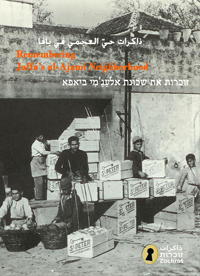Excerpt from the booklet:
Introduction
A few weeks ago bulldozers from the Tel Aviv-Jaffa municipality demolished the Adassi's family home in Jaffa's Ajami neighborhood. Political and social activists opposed to the municipality's policy of demolishing homes in the area and removing Palestinian residents from the last remaining Arab neighborhood in Jaffa tried to rebuild the house. The authorities responded quickly and efficiently; the bulldozers returned and uprooted the new foundations. This time they also removed the rubble, as if to remove evidence from a crime scene. The bulldozers cleared the area, and the municipality planted olive trees where the Palestinian home once stood. The olive tree is a symbol of peace and tranquility in many cultures, including among the Jews and the Arabs. The result of this incident is, of course, a disaster for the Adassi family. But it would be naïve to think of this as an individual, isolated case. The message it sends is clear: Peace and tranquility in this country will come only by force, according to the will of those who make the decisions - in this case, the Zionist establishment, which is able to pass laws that meet its needs and then claim that it acts only according to the law. It's shocking to think that peace will come only after the Palestinian is expelled. How it hurts to think of using beautiful trees in order to hide the signs of purposeful destruction, and to conceal additional evidence that people lived here for many, many years. This is a true story - Jaffa, 2007.
The use of plants and trees to create a new landscape and conceal the older one so as to transform how we think about that place, distort its history and deceive the onlooker is a familiar tactic of the Zionist movement and a definite policy of the Israeli government. Dozens of Palestinian villages that were demolished by the Zionists at the beginning of the Nakba were replaced by woods or parks - Lavi forest where the village of Lubia stood, or Menashe Park in place of a number of the area's villages, among them Kafar al-Mansi. The state behaved the same way in some of the areas occupied in 1967 - the Latrun villages, on whose ruins Canada-Ayalon Park was established. Shrubs and trees hide the Israeli side of the separation wall, and the traveler on Route 6 won't notice that the lovely plantings hide the terrible wall and the Palestinians jailed behind it. On the face of things - from the Israeli side - the scenery is pretty and the situation calm. The visitor to the site of the Adassi family's house in the al-Ajami neighborhood will get the same impression.
"The Nakba only began in 1948, and it still continues." That's not a cliché. What's happening these days to Jaffa's Arabs is proof that the Palestinian Nakba is still going on. Zochrot, which recalls and remembers the Palestinian villages that once existed here and were demolished when Israel was established, is presenting the story of the al-Ajami neighborhood of Jaffa. We chose al-Ajami because of hundreds of demolition and "vacate" orders that its residents have received in recent months, and because of the very real danger that the neighborhood will be emptied of its Palestinian residents, many of whom have been living there for dozens of years, some whose families have owned their homes and land for generations and others brought to the neighborhood after having been expelled from their own homes in 1948. There's no way to ignore the fact that al- Ajami, at which the establishment is now aiming, is almost the last neighborhood in Jaffa which has retained its Arab character and majority Arab population.
The al-Ajami neighborhood has close connections to the events of 1948 and to the ethnic cleansing of Jaffa and the surrounding villages. Al-Ajami is etched in Palestinians' - and certainly Jaffa residents' - collective memory, as a ghetto where the survivors of the Nakba in the Jaffa area were concentrated and imprisoned for a few months, and which they were forbidden to leave without the Israeli Military Governor's authorization. The ongoing Nakba is evident from the range of writers and person interviewed for this publication. In most places, we depend on interviews with, and testimonies from, men and women who themselves became refugees and experienced at first hand the events of 1948. They guide our tour of their destroyed locality. They are, of course, elderly men and women from the first Nakba generation. This generation now naturally joins those who follow it, and their activities combine memory, knowledge, current events, research and personal experiences. Dr. Daniel Montrescu prepared a wonderful article for us on "planning" policy in Jaffa; Sami Bah'ari shared his experiences and his memories with us. We interviewed our friend, Sami abu Shehada, despite his youth, and heard chilling stories and intelligent analyses of how Jaffa is being "made Jewish." When we spoke to both Bah'ari and to abu Shehada, their grandfathers were present. In addition, refugees and residents will recall the events of 1948, and what life in Jaffa was like before then. Finally, we present the case of the al-Faran family, which has been ordered to vacate its home.
This booklet appears on the occasion of the tour Zochrot has organized of the al-Ajami neighborhood, in cooperation with local activitists, in the shadow of demolitions and orders to residents to vacate their homes. As we do in the booklet, the tour will link the history of the neighborhood to what's happening there today. We'll also erect street signs which show the original street names.
This is the twenty-third such booklet and tour that Zochrot has undertaken. The others are: Dayr Yassin, Lifta, Ayn Ghazzal, al-Haram (Sidna Ali), Ayn al-Mansi, Haifa, Acre, Lydda, Ramle, Kirbet al-Jalame, Isdud/al-Majdal, al-Sheikh Muwannis, al-Julan, Suhmata, al-Lajjun, Ijlil, Bir a-Sab'e, Tarshiha, al-Shajara, al-Kafrayn, Hittin, and the Latrun villages of Yalu, Imwas, and Bayt Nuba.
Zochrot
September, 2007
Download File



